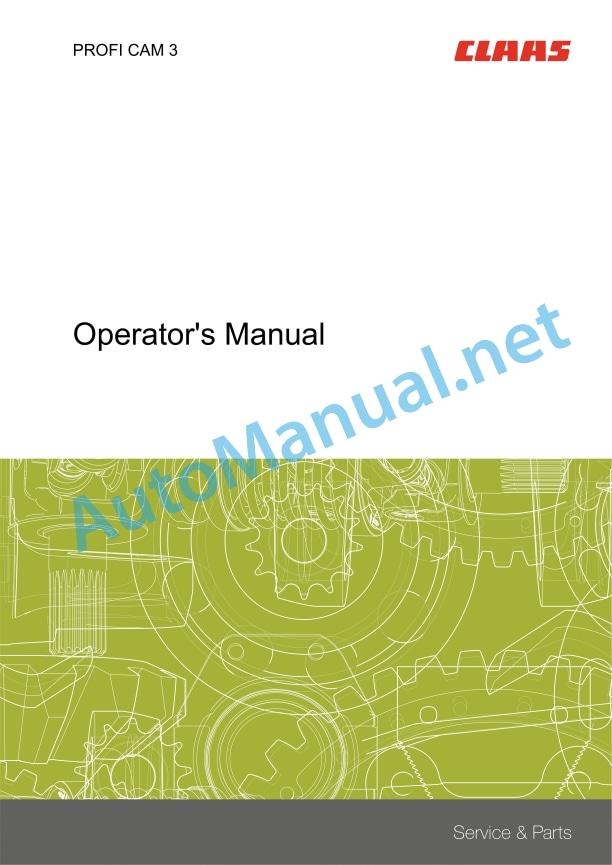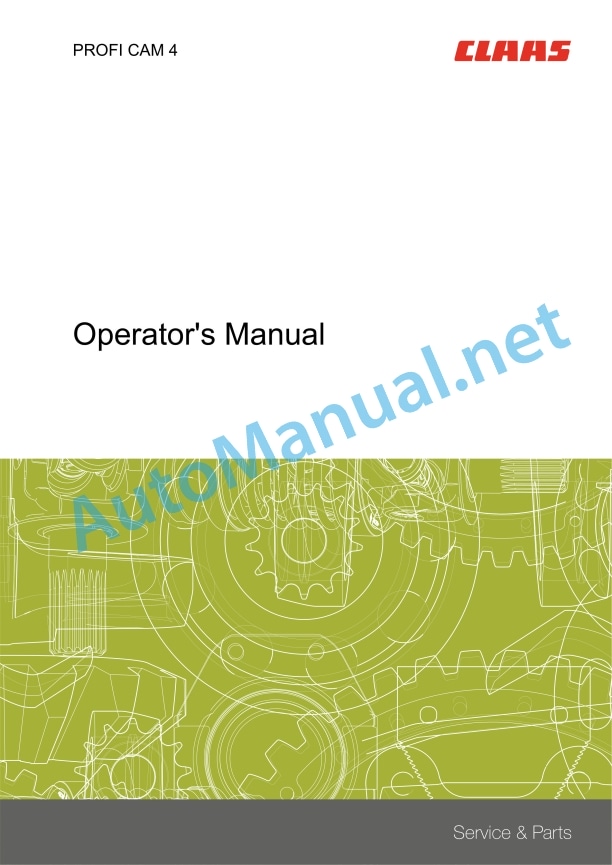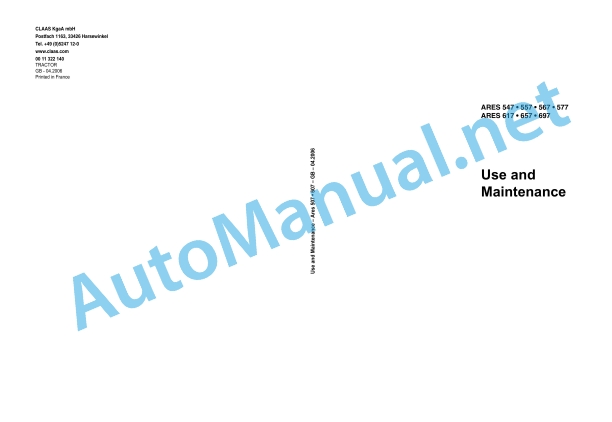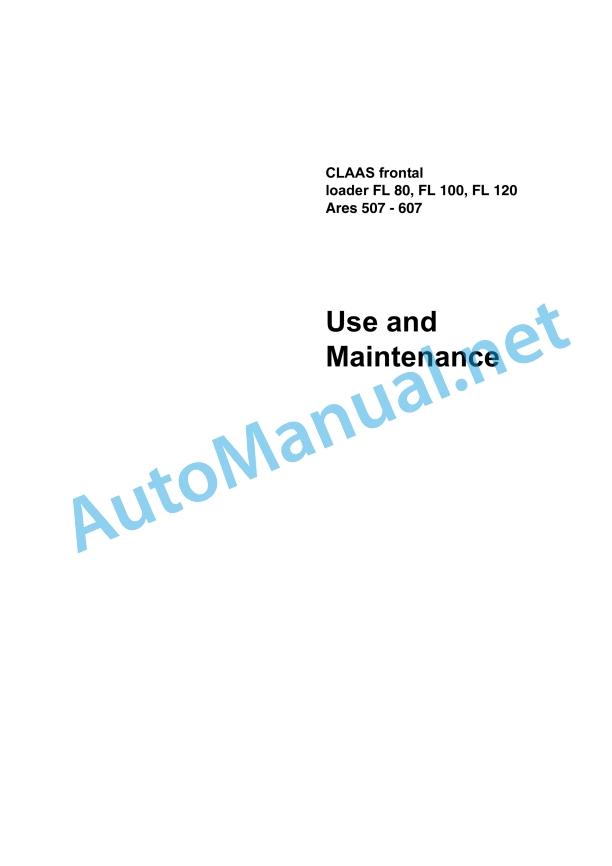Claas Ares 697-617 Atz (A03) Tractors Operator Manual EN
$50.00
- Model: Ares 697-617 Atz (A03) Tractors
- Type Of Manual: Operator Manual
- Language: EN
- Format: PDF(s)
- Size: 106 MB
File List:
00 0290 452 0.pdf
00 0301 051 0.pdf
00 0303 482 0.pdf
00 1132 214 0.pdf
00 1133 397 0.pdf
00 1169 984 0.pdf
60 0501 632 2.pdf
00 0290 452 0.pdf:
Contents
1 Introduction
1.1 General Information
1.1.1 How to use this manual
1.1.2 Validity of manual
1.1.3 Specifications
1.1.4 Licensing for road traffic
1.2 Various components / Machine body
1.2.1 Spare parts and technical questions
1.2.2 GPS PILOT monitor identification plate
1.2.3 Base station identification plate
2 Safety
2.1 General Information
2.1.1 General information
2.1.2 Important information
2.1.3 Intended use
2.1.4 Accumulators
2.2 Safety rules
2.2.1 Identification of warning and danger signs
3 Sectional view of machine
3.1 Antennas – Overview
3.1.1 GPS antenna (BASELINE HD, SBAS)
3.1.2 Antenna (BASELINE HD)
3.1.3 GPS antenna (OMNISTAR HP, RTK)
3.1.4 Antenna (RTK)
3.2 Signal overview
3.2.1 GPS PILOT SBAS
3.2.2 GPS PILOT OMNISTAR
3.2.3 GPS PILOT BASELINE HD
3.2.4 GPS PILOT RTK
3.3 GPS PILOT monitor
3.3.1 Connections at the rear of the GPS PILOT monitor
3.3.2 Connections on the left of the GPS PILOT monitor
3.4 Base station for BASELINE HD
3.4.1 Base station
3.4.2 Charger (up to serial no. …)
3.4.3 Charger (from serial no. …)
3.4.4 Cable for external power supply
3.4.5 Cable for PC connection
4 Prior to initial operation
4.1 General Information
4.1.1 General warnings
4.2 Initial operation of base station
4.2.1 Base station initial operation check list
4.2.2 Making the charger (up to serial no. …) available
4.2.3 Making the charger (from serial no. …) available
4.2.4 Charging the base station battery
4.2.5 Switching on the base station
4.2.6 Supplying the base station with an external battery
4.2.7 Changing the base station frequency
4.3 GPS antenna initial operation (OMNISTAR HP, RTK)
4.3.1 Check list for initial operation of GPS antenna (OMNISTAR HP, RTK)
4.3.2 Having the GPS antenna enabled (OMNISTAR HP, RTK)
4.4 Initial operation of GPS PILOT monitor
4.4.1 Check list for initial operation of GPS PILOT monitor
4.5 Initial operation
4.5.1 LEXION initial operation check list
4.5.2 COUGAR initial operation check list
4.5.3 XERION initial operation check list
4.5.4 Tractor initial operation check list
5 Prior to each operation
5.1 General Information
5.1.1 General warnings
5.1.2 Preparing fieldwork with the GPS PILOT
6 GPS PILOT operation
6.1 General Information
6.1.1 General warnings
6.2 Settings and displays
6.2.1 Layout conventions of buttons and displays
6.2.2 Overview of buttons
6.2.3 Start screen
6.3 Operation of screen menus
6.3.1 Basic settings
6.3.2 GPS status information
6.3.3 Steering settings
6.3.4 Machine settings
6.3.5 Job management
6.3.6 Field view
6.3.7 Function buttons in the screen menus
7 GPS PILOT fieldwork
7.1 General Information
7.1.1 General warnings
7.2 Base station
7.2.1 Setting up the base station
7.2.2 Switching on the base station
7.2.3 Setting the frequency with BASELINE HD
7.3 LEXION
7.3.1 Learning the ATP front attachment zero point
7.3.2 Selecting the AUTOPILOT signal (from CEBIS version 8.2)
7.3.3 Learning the steering zero point
7.3.4 Switching on the AUTO PILOT
7.3.5 Switching off the AUTO PILOT
7.4 COUGAR
7.4.1 Enabling the AUTO PILOT
7.4.2 Selecting the AUTO PILOT signal
7.4.3 Switching on the AUTO PILOT
7.4.4 Switching off the AUTO PILOT
7.5 XERION
7.5.1 Enabling the AUTO PILOT
7.5.2 Selecting the AUTO PILOT signal
7.5.3 Switching on the AUTO PILOT
7.5.4 Switching off the AUTO PILOT
7.6 Tractor
7.6.1 Switching the eDrive box on / off
7.6.2 Switching on the AUTO PILOT
7.6.3 Switching off the AUTO PILOT
7.6.4 Basic settings
7.6.5 Entering the antenna height
7.6.6 Calibrating the inclination sensor
7.6.7 Setting the steering adjustment.
7.6.8 Adjusting the steering speed
7.7 Performing fieldwork with the GPS PILOT
7.7.1 Types of field drives
7.7.2 Activate straight guidance.
7.7.3 Activating contour guidance
7.7.4 Activating circular guidance
7.7.5 Relocating A=B lines in the A=B mode
8 Maintenance
8.1 General Information
8.1.1 General warnings
8.2 Electric system / Electronics
8.2.1 Battery
8.2.2 Removing / installing the base station battery
00 0301 051 0.pdf:
PROFI CAM 3
Table of contents
1 Introduction
1.1 Notes on the manual
1.1.1 Validity of manual
1.1.2 Information about this Operator’s Manual
1.1.3 Symbols and notes
1.1.4 Optional equipment
1.1.5 Qualified specialist workshop
1.1.6 Maintenance information
1.1.7 Warranty notes
1.1.8 Spare parts and technical questions
1.2 Intended use
1.2.1 Intended use
1.2.2 Reasonably foreseeable misuse
2 Safety
2.1 Identifying warnings
2.1.1 Hazard signs
2.1.2 Signal word
2.2 Safety rules
2.2.1 Meaning of Operator’s Manual
2.2.2 Observing safety decals and warnings
2.2.3 Optional equipment and spare parts
3 Product description
3.1 Overview and method of operation
3.1.1 How the PROFI CAM works
3.2 Identification plates and identification number
3.2.1 Position of identification plates
3.2.2 Explanation of PROFI CAM identification plate
3.3 Information on the product
3.3.1 CE marking
4 Operating and control elements
4.1 Camera system
4.1.1 Camera system monitor
4.2 Menu structure
4.2.1 Main menu
4.2.2
4.2.3
4.2.4
4.2.5
4.2.6
5 Technical specifications
5.1 PROFI CAM
5.1.1 Monitor
5.1.2 Camera
5.1.3 Switch box
5.1.4 Degree of protection against foreign bodies and water
6 Preparing the product
6.1 Shutting down and securing the machine
6.1.1 Switching off and securing the machine
6.2 Prior to operation
6.2.1 Carry out prior to operation
6.2.2 Installing the sun protection
6.2.3 Aligning the camera
6.2.4 Connecting the camera electrics
7 Operation
7.1 Monitor
7.1.1 Switching on the monitor
7.1.2 Calling up the menu
7.1.3 Setting a menu item
7.1.4 Setting the image orientation
7.1.5 Setting automatic screen darkening
7.1.6 Image mirroring
7.1.7 Setting the trigger view
7.1.8 Setting the follow-up time for trigger view
7.1.9 Setting the display mode
7.1.10 Activating/deactivating a display mode
8 Faults and remedies
8.1 Electrical and electronic system
8.1.1 Overview of problems on PROFI CAM camera system
8.1.2 Replacing the switch box fuse
9 Maintenance
9.1 Maintenance intervals
9.1.1 Every 10 operating hours or daily
9.2 Camera system
9.2.1 Checking the camera system for dirt
9.2.2 Cleaning the camera
9.2.3 Cleaning the switch box
9.2.4 Cleaning the monitor
10 Placing out of operation and disposal
10.1 General Information
10.1.1 Putting out of operation and disposal
11 Technical terms and abbreviations
11.1 Abbreviations
11.1.1 Units
11.1.2 Abbreviations
11.1.3 Technical terms
00 0303 482 0.pdf:
PROFI CAM 4
Table of contents
1 Introduction
1.1 Notes on the manual
1.1.1 Validity of manual
1.1.2 Information about this Operator’s Manual
1.1.3 Symbols and notes
1.1.4 Optional equipment
1.1.5 Qualified specialist workshop
1.1.6 Maintenance information
1.1.7 Notes on warranty
1.1.8 Spare parts and technical questions
1.2 Intended use
1.2.1 Intended use
1.2.2 Reasonably foreseeable misuse
2 Safety
2.1 Identifying warnings
2.1.1 Hazard signs
2.1.2 Signal word
2.2 Safety rules
2.2.1 Meaning of Operator’s Manual
2.2.2 Structural changes
2.2.3 Optional equipment and spare parts
2.2.4 Operation only following proper putting into operation
2.2.5 Technical status
2.2.6 Respecting technical limit values
Respecting technical limit values
2.2.7 Hazards when driving on roads and fields
3 Product description
3.1 Overview and method of operation
3.1.1 How the PROFI CAM works
3.2 Identification plates and identification number
3.2.1 Identification plates
3.3 Information on the product
3.3.1 CE marking
4 Operating and display elements
4.1 Camera system
4.1.1 Camera system monitor
4.1.2 CEBIS
4.2 Menu structure
4.2.1 Main menu
4.2.2
4.2.3
4.2.4
4.2.5
4.2.6
5 Technical specifications
5.1 PROFI CAM
5.1.1 Monitor
5.1.2 Camera
5.1.3 Switch box
6 Preparing the product
6.1 Switching off and securing the machine
6.1.1 Switching off and securing the machine
6.2 Prior to putting into operation
6.2.1 Carry out prior to operation
6.2.2 Installing the sun protection
6.2.3 Aligning the camera
7 Operation
7.1 Monitor
7.1.1 Switching on the monitor
7.1.2 Calling up the menu
7.1.3 Setting a menu item
7.1.4 Setting the image orientation
7.1.5 Setting automatic screen darkening
7.1.6 Image mirroring
7.1.7 Setting the trigger view
7.1.8 Setting the follow-up time for trigger view
7.1.9 Setting the display mode
7.1.10 Activating/deactivating a display mode
8 Faults and remedies
8.1 Electric and electronic system
8.1.1 Overview of problems on PROFI CAM camera system
9 Maintenance
9.1 Maintenance intervals
9.1.1 Every 10 operating hours or daily
9.2 Camera system
9.2.1 Checking the camera system for dirt
9.2.2 Cleaning the camera
9.2.3 Cleaning the switch box
9.2.4 Cleaning the monitor
10 Putting out of operation and disposal
10.1 General information
10.1.1 Putting out of operation and disposal
11 Technical terms and abbreviations
11.1 Abbreviations
11.1.1 Units
11.1.2 Abbreviations
11.1.3 Technical terms
00 1133 397 0.pdf:
CLAAS frontal loader FL 80, FL 100, FL 120
Ares 507 – 607
Use and Maintenance
For your safety
Warning triangle
Appropriate use
Loader FL 80
Ares 547
Loader FL 100
Ares 547 – 557 – 567 – 577 – 617
Loader FL 120
617 – 657 – 697
SOMMAIRE
0011333970_GB_005-006.pdf
CONTENTS
CLAAS frontal loader
Identification 8
Safety 9
Failure to comply with rules for safety and use 9
Safety stickers with warning pictograms 12
Frontal loader characteristics 14
Control 15
Unhitching of the frontal loader 16
Linkage of the frontal loader 19
Linkage of the tool 21
Unhitching of the tool 22
Level indicator 23
PCH system 23
Maintenance of the frontal loader 24
Maintenance on the tractor with frontal loader 24
Statement of compliance 26
0011333970_GB_007-026.pdf
CLAAS frontal loader
Identification
CERTIFICATE OF COMPLIANCE
FOREWORD
PRECAUTIONS BEFORE STARTING
Failure to comply with rules for safety and use
Condition of the frontal loader
ADJUSTMENT OR MAINTENANCE – REPAIRS
Hydraulics
ROAD USE – USE FOR TRANSPORT
Operation
GENERAL RULE
Axle load
Safety stickers with warning pictograms
Frontal loader characteristics
ACTIVATION
For the Propilot (1)
For the Flexpilot (2)
Operation
1st function
2nd function
3rd function
4th function
Unhitching of the frontal loader
Operation on left side
Operations on right side
Linkage of the frontal loader
Operations on right side
Operations on left side
Linkage of the tool
Unhitching of the tool
Level indicator
PCH system
Maintenance of the frontal loader
Maintenance on the tractor with frontal loader
Statement of compliance
00 1169 984 0.pdf:
Sensor case for tractors Stage IIIB, IV and VSensor case for tractors Stage IIIB, IV and VSensor case for Stage IIIB, IV and V tractors
Contents
1 Sensorkoffer – Sensor case – Sensor suitcase – Stage IIIB, IV & V
1.1 Auflistung Kofferinhalt
1.1 Listing case content
1.1 Presentation of the contents of the suitcase
60 0501 632 2.pdf:
6005016322-GB-version06.01156.pdf
Page – 2 –
Page – 3 –
Page – 4 –
Page – 5 –
Page – 6 –
Page – 7 –
Page – 8 –
Page – 9 –
Page – 10 –
Page – 11 –
Page – 12 –
Page – 13 –
Page – 14 –
Page – 15 –
Page – 16 –
Page – 17 –
Page – 18 –
Page – 19 –
Page – 20 –
Page – 21 –
Page – 22 –
Page – 23 –
Page – 24 –
Page – 25 –
Page – 26 –
Page – 27 –
Page – 28 –
Page – 29 –
Page – 30 –
Page – 31 –
Page – 32 –
Page – 33 –
Page – 34 –
Page – 35 –
Page – 36 –
Page – 37 –
Page – 38 –
Page – 39 –
Page – 40 –
Page – 41 –
Page – 42 –
Page – 43 –
Page – 44 –
Page – 45 –
Page – 46 –
Page – 47 –
Page – 48 –
Page – 49 –
Page – 50 –
Page – 51 –
Page – 52 –
Page – 53 –
Page – 54 –
Page – 55 –
Page – 56 –
Page – 57 –
Page – 58 –
Page – 59 –
Page – 60 –
Page – 61 –
Page – 62 –
Page – 63 –
Page – 64 –
Page – 65 –
Page – 66 –
Page – 67 –
Page – 68 –
Page – 69 –
Page – 70 –
Page – 71 –
Page – 72 –
Page – 73 –
Page – 74 –
Page – 75 –
Page – 76 –
Page – 77 –
Page – 78 –
Page – 79 –
Page – 80 –
Page – 81 –
Page – 82 –
Page – 83 –
Page – 84 –
Page – 85 –
Page – 86 –
Page – 87 –
Page – 88 –
Page – 89 –
Page – 90 –
Page – 91 –
Page – 92 –
Page – 93 –
Page – 94 –
Page – 95 –
Page – 96 –
Page – 97 –
Page – 98 –
Page – 99 –
Page – 100 –
Page – 101 –
Page – 102 –
Page – 103 –
Page – 104 –
Page – 105 –
Page – 106 –
Page – 107 –
Page – 108 –
Page – 109 –
Page – 110 –
Page – 111 –
Page – 112 –
Page – 113 –
Page – 114 –
Page – 115 –
Page – 116 –
Page – 117 –
Page – 118 –
Page – 119 –
Page – 120 –
Page – 121 –
Page – 122 –
Page – 123 –
Page – 124 –
Page – 125 –
Page – 126 –
Page – 127 –
Page – 128 –
Page – 129 –
Page – 130 –
Page – 131 –
Page – 132 –
Page – 133 –
Page – 134 –
Page – 135 –
Page – 136 –
Page – 137 –
Page – 138 –
Page – 139 –
Page – 140 –
Page – 141 –
Page – 142 –
Page – 143 –
Page – 144 –
Page – 145 –
Page – 146 –
Page – 147 –
Page – 148 –
Page – 149 –
Page – 150 –
Page – 151 –
Page – 152 –
Page – 153 –
Page – 154 –
Page – 155 –
Page – 156 –
Page – 157 –
Page – 158 –
Page – 159 –
Page – 160 –
Page – 161 –
Page – 162 –
Page – 163 –
Page – 164 –
Page – 165 –
Page – 166 –
Page – 167 –
Page – 168 –
Page – 169 –
Page – 170 –
Page – 171 –
Page – 172 –
Page – 173 –
Page – 174 –
Page – 175 –
Page – 176 –
Page – 177 –
Page – 178 –
Page – 179 –
Page – 180 –
Page – 181 –
Page – 182 –
Page – 183 –
Page – 184 –
Page – 185 –
Page – 186 –
Page – 187 –
Page – 188 –
Page – 189 –
Page – 190 –
Page – 191 –
Page – 192 –
Page – 193 –
Page – 194 –
Page – 195 –
Page – 196 –
Page – 197 –
Page – 198 –
Page – 199 –
Page – 200 –
Page – 201 –
Page – 202 –
Page – 203 –
Page – 204 –
Page – 205 –
Page – 206 –
Page – 207 –
Page – 208 –
Page – 209 –
Page – 210 –
Page – 211 –
Page – 212 –
Page – 213 –
Page – 214 –
Page – 215 –
Page – 216 –
Page – 217 –
Page – 218 –
Page – 219 –
Page – 220 –
Page – 221 –
Page – 222 –
Page – 223 –
Page – 224 –
Page – 225 –
Page – 226 –
Page – 227 –
Page – 228 –
Page – 229 –
John Deere Repair Technical Manual PDF
John Deere Repair Technical Manual PDF
John Deere Repair Technical Manual PDF
John Deere Repair Technical Manual PDF
John Deere POWERTECH E 4.5 and 6.8 L Diesel Engines TECHNICAL MANUAL 25JAN08
John Deere Repair Technical Manual PDF
John Deere Diesel Engines POWERTECH 2.9 L Component Technical Manual CTM126 Spanish
John Deere Repair Technical Manual PDF
John Deere Repair Technical Manual PDF
John Deere Repair Technical Manual PDF
John Deere 18-Speed PST Repair Manual Component Technical Manual CTM168 10DEC07
New Holland Service Manual PDF



























